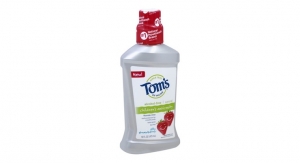06.12.19
It’s a giant step for Colgate, with the announcement that the company has finalized the design of “a first-of-its kind recyclable toothpaste tube that sets a new standard in the industry.” The Association of Plastic Recyclers (APR) last week announced its recognition of the new tube – an essential step in bringing it to the public. The Colgate design is the first oral care or personal care tube to earn APR recognition for recyclability.
Under development for more than five years, the tube will debut under the company’s Tom’s of Maine brand in the U.S. in 2020. Roll out to select global markets under the Colgate brand will follow. The company plans to fully convert to recyclable tubes by 2025, when all of its
products will be in 100% recyclable packaging.
“Building a future to smile about means finding new packaging solutions that are better for the planet, but until now there hasn’t been a way to make toothpaste tubes part of the recycling stream,” said Justin Skala, executive vice president, chief growth & strategy officer for Colgate-Palmolive. “Once we’ve proven the new tube with consumers, we intend to offer the technology to the makers of plastic tubes for all kinds of products. By encouraging others to use this technology, we can have an even bigger impact and increase the long-term market viability of this solution.”
Toothpaste accounts for an estimated 20 billion tubes annually around the world.
To make a recyclable tube, Colgate chose high-density polyethylene (HDPE), the widely recycled “No. 2” plastic popular for bottle making. But because HDPE is rigid, it isn’t well suited for ultra-thin laminate sheets and soft, squeezable tubes.
Colgate’s “eureka moment” came when company packaging engineers working at its Piscataway, NJ, technology campus recognized that they could use more than one grade of HDPE in their designs. The team then tested a dozen different combinations – using from six to 20 layers – to find the recipe that allows people to comfortably squeeze out all the toothpaste, protects the integrity of the product, and meets the demands of high-speed production.
To achieve APR recognition, Colgate also conducted tests to show that its toothpaste tube could navigate the screens and conveyor belts at the critically important Materials Recovery Facilities that sort recyclables. Colgate used Radio Frequency Identification tags to track
the tubes and prove they would be properly sorted with plastic bottles. And to demonstrate that the recyclable tube material could be repurposed after recycling – another critical part of gaining APR recognition – the company ground up the tubes to successfully make new plastic bottles.
There’s still a way to go but APR and Colgate say it’s a very promising start.
Colgate-Palmolive ranked No. 17 on Beauty Packaging's list of Top 20 global beauty companies.
Under development for more than five years, the tube will debut under the company’s Tom’s of Maine brand in the U.S. in 2020. Roll out to select global markets under the Colgate brand will follow. The company plans to fully convert to recyclable tubes by 2025, when all of its
products will be in 100% recyclable packaging.
“Building a future to smile about means finding new packaging solutions that are better for the planet, but until now there hasn’t been a way to make toothpaste tubes part of the recycling stream,” said Justin Skala, executive vice president, chief growth & strategy officer for Colgate-Palmolive. “Once we’ve proven the new tube with consumers, we intend to offer the technology to the makers of plastic tubes for all kinds of products. By encouraging others to use this technology, we can have an even bigger impact and increase the long-term market viability of this solution.”
Toothpaste accounts for an estimated 20 billion tubes annually around the world.
To make a recyclable tube, Colgate chose high-density polyethylene (HDPE), the widely recycled “No. 2” plastic popular for bottle making. But because HDPE is rigid, it isn’t well suited for ultra-thin laminate sheets and soft, squeezable tubes.
Colgate’s “eureka moment” came when company packaging engineers working at its Piscataway, NJ, technology campus recognized that they could use more than one grade of HDPE in their designs. The team then tested a dozen different combinations – using from six to 20 layers – to find the recipe that allows people to comfortably squeeze out all the toothpaste, protects the integrity of the product, and meets the demands of high-speed production.
To achieve APR recognition, Colgate also conducted tests to show that its toothpaste tube could navigate the screens and conveyor belts at the critically important Materials Recovery Facilities that sort recyclables. Colgate used Radio Frequency Identification tags to track
the tubes and prove they would be properly sorted with plastic bottles. And to demonstrate that the recyclable tube material could be repurposed after recycling – another critical part of gaining APR recognition – the company ground up the tubes to successfully make new plastic bottles.
There’s still a way to go but APR and Colgate say it’s a very promising start.
Colgate-Palmolive ranked No. 17 on Beauty Packaging's list of Top 20 global beauty companies.




























